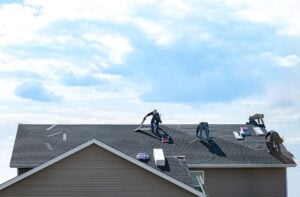It’s nerve-wracking to find a leak in your roof. The common response? Head to the local hardware store and grab some sealant. But is a water leak sealant the best solution? Let’s find out.

Using Sealants
Sealants act as a secondary defense against water intrusion and should never be the first line of defense to keep a roof from leaking. For instance, covering a roof full of cracks with sealant is not advisable because you aren’t addressing the underlying structural issues.
Similarly, you can’t count on roof sealant spray on a 20-50-year-old roof system because, eventually, it will break down due to UV exposure. As a result, your roof will have problems that can lead to its failure.
The Risks of A DIY Roof Repair
A poor repair job gives you a false sense of security because the project can look great initially but quickly backfire down the line. The reason? Roof leaks are sneaky and are barely noticeable until they do severe damage. Some of the hazards include:
- Mold and mildew growth. This affects the ceiling, walls, furniture and clothing. And if the roof leaks persist, black molds might develop around your house, which can be hard and expensive to remove.
- Structural damage. Major roof leaks can cause serious harm to your attic and ceilings.
- Electrical system issues. Roof leaks increase the fire risk because they can cause short circuits in your attic or ceilings.
- Higher utility costs. A leaking roof can compromise insulation and increase heating and cooling costs.
And remember this: It’s easy to think we’re discouraging the use of sealants because we want to charge you a fortune—far from it. You may consider using a quality sealant that will get you by while you wait for your roofing contractor to come out and get you a free estimate. But that’s not the case. A roof leak can cost you more money in the long run because applying the sealant will make it more difficult for your contractor to repair or replace the roof.
So how do professionals stop a leaking roof?
- They will climb up on the roof and do an inspection. The objective is to determine the root cause of a roof leak, whether it’s a damaged roof, failed flashing, leaking skylights, deteriorated shingles, clogged downpipes, cracked tiles, or pooling water.
- After the examination, the professional will discuss your options and the projected timelines. However, it’s important to remember that every situation is different and therefore requires a unique approach.
Advantages Of Roof Replacement
Sometimes replacing part or all of your home’s leaking roof is the most effective and cost-efficient solution. Here are some of the benefits:
- Additional strength to your house. As a roof ages, it becomes structurally unsound and unable to endure the things it was designed to defend against. On the other hand, a new roof repels water and protects against falling trees, debris, and the wind.
- A healthier home. One of the biggest challenges facing old roofs is water and moisture creeping inside the house. Even if it’s a small leak, condensation can build up over time, creating mold and mildew that pose health risks to your family.
- The chance to use green and energy-efficient materials. Getting rid of an older and environmentally unfriendly roofing system means your HVAC system doesn’t have to work as hard, reducing your utility bill.
What You Need to Do
Roof leaks are a significant hassle. But one of the biggest dangers of DIY roof leak repairs, such as roofing tar, is slipping and falling through or off the roof. In other words, a simple roof leak can escalate into a life-threatening disaster.
That’s why you need a professional roofing contractor who can deal with various roofing styles and prevent leaks. Call Jack C Wilson Roofing Company to assess the actual condition of your roof and give you a free estimate.

